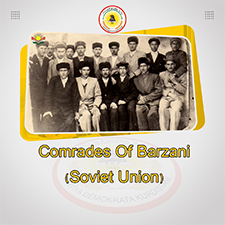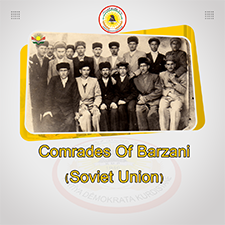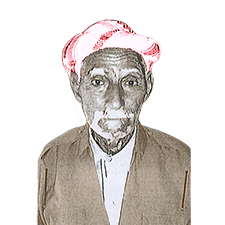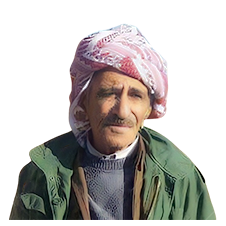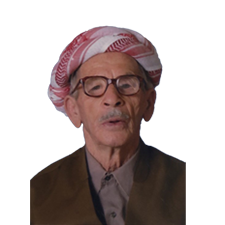Biography
Badin Qadr was born in 1918 in the village of “Dezuye” which was a part of Erbil. Before his journey to the Soviet Union, he marries a woman named Shirin Jundi Sleman. Together they had a daughter named Fahima in 1945. Additionally, He married his second wife, Aesha Bilal, in the Soviet Union. They had a daughter named Jawahir in 1951. When Badin decides to return to Kurdistan from the Soviet Union, His wife and daughter decide to stay in Uzbekistan.
In 1945, Badin Qadr contacted the soldiers of the second Barzani revolution when he was only 13. Because of his age, his job was delivering food to the Peshmergas.
On the 11th of October in 1945, after the fall of the second Barzani revolution, Badin travels to eastern Kurdistan along with his family and Mustafa Barzani. Furthermore, he joins the ranks of the Barzani army in The Republic of Kurdistan on the 31st of March in 1946.
Following the fall of the Kurdistan Democratic Party (KDP) in Mahabad and the return of Barzani from eastern Kurdistan to southern Kurdistan, Badin participated in the battles of “Naghada” and “Shno” in eastern Kurdistan. Also, he was one of those peshmergas on 19/4/1947 who went through the road of “Khwakurk u Dashti Baraz grawa” on the land of northern Kurdistan to return to “Sherwan” and “Mzuri”. After their return, General Mustafa Barzani on 15/5/1947 in the village of “Argush” conducted a meeting with his comrades and gave them the freedom of whether to stay or go to the Soviet Union. In the meeting, everyone decides to leave and go to the Soviet Union. On the 23rd of May in 1947, Badin travels with General Mustafa to the Soviet Union and fights in the battles of “Gali Qtur” and the “Mangoor”. After a lot of hardships, on the 18th of June in 1947, he was able to travel to the Soviet Union after passing through the Aras River which was between the borders of Iran and the Soviet Union.
After their arrival at the Soviet Union on the 19th of June in 1947 in the city of “Akhchawan” in the Republic of Azerbaijan, all of the comrades were placed in a community that was surrounded by barbed wire. They were being monitored by the soldiers and were treated like hostages of war when it came to food and clothes. Afterwards, the Soviet government decided that the comrades should be divided into the places of “Aghdam”, “Lachin”, “Ayulax” and “Kalbajar” in the Republic of Azerbaijan. On the 10th of December in 1947, they were transported to a military camp on the lake of “Khazar” in the capital of the Republic of Mahabad “Bakor”. On the 23rd of the same month, they were given military clothes and were trained by the officers of the republic 8 hours a day. On top of that, some of the comrades that were literate in Kurdish would teach the language for 4 hours a day.
After the ill-treatment of “Jaafar Baqrov” with the comrades, on the 29th of August in 1949, Barzani decides to transport his military camp from the republic of Mahabad to a “Chrchuk” community near the city of “Ashkand” which was the capital of Uzbekistan; there they continued their military practices.
In March of 1949, the comrades were divided into the villages of the Soviet Union and farms (where civilians would rent them from the governments and pay them back later). The comrades were working in these places.
Following multiple letters to Stalin by General Barzani, a letter finally reaches Stalin where it talks about the hardships the comrades are going through. Stalin immediately creates a party to investigate the comrades of Barzani; the party comes to the decision that everyone should gather in the city of “Vrivsky”. Everyone travels to the city in November of 1951.
After the July 14, 1958, revolution in Iraq and the return of General Mustafa Barzani, on February 25, 1959, according to both Articles 3 and 7, paragraph (a) of Article 10 and according to Article (11), and based on the amended law No. 19, General Mustafa Barzani and his comrades were granted general amnesty.
After they were granted a general amnesty, Badin along with his comrades travels back to southern Kurdistan with the ship “Grozya” through the harbor of “Basra”. Moreover, he participated in the “Aylul” revolution. In 1963 he gets killed in the village of “Spindara”, and he gets buried there.
Sources:
- حهمید گهردی، پوختهی مێژوونامه، چاپی یهكهم، (ههولێر - دهزگای چاپ و بڵاوكردنهوهی ئاراس - چاپخانهی وهزارهتی پهروهرده - ٢٠٠٤).
- حیدر فاروق السامرائي، ضیاء جعفر و دوره السیاسي و الاقتصادي في العراق، (لندن – دارالحكمة - ٢٠١٦).
- مسعود بارزانی، بارزانی و بزوتنهوهی ڕزگاریخوازی كورد ١٩٣١ - ١٩٥٨، (دهۆك - چاپخانهی خهبات - ١٩٩٨).
- ئەرشیفی دەستەی ئینسکلۆپیدیا، ١٣ نیسانی ٢٠١٩- پیرمام.
- نص قرار لجنة العفو العام برد الاعتبار الى شهداء ثورة بارزان، مجلة رزگاری، العدد ٣،٢، المطبعة الرابطة، بغداد، ١ نيسان ١٩٥٩.




